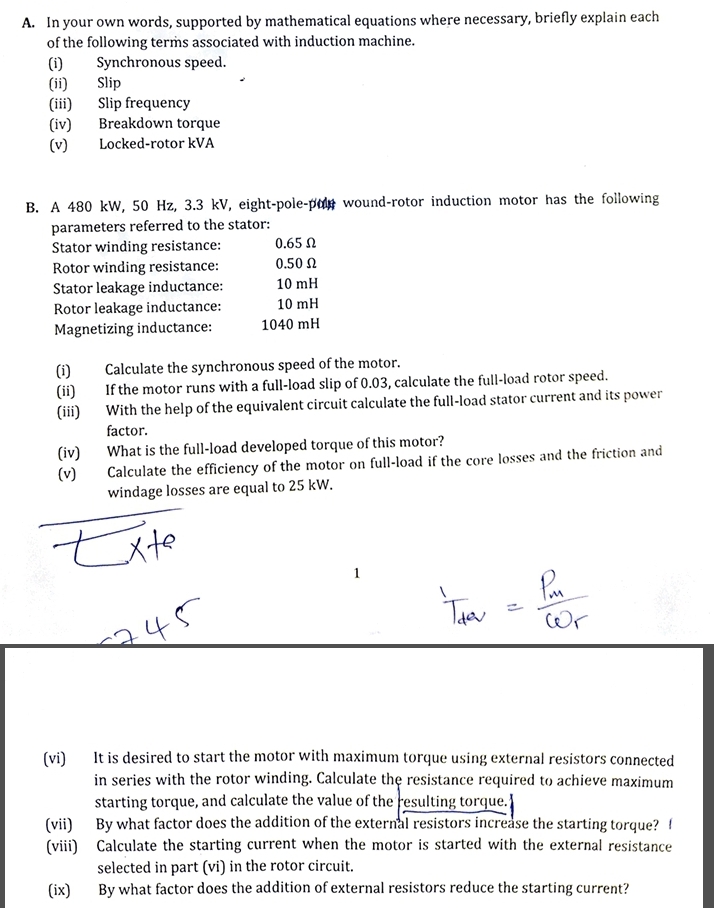A 480 kW, 50 Hz, 3.3 kV, eight-pole-ped wound-rotor induction motor has the following parameters referred to the stator: Stator winding resistance: Rotor winding resistance: 0.65 0.50 Ω Stator leakage inductance: 10 mH Rotor leakage inductance: Magnetizing inductance: 10 mH 1040 mH Calculate the synchronous speed of the motor. (1) (ii) If the motor runs with a full-load slip of 0.03, calculate the full-load rotor speed. (iii) With the help of the equivalent circuit calculate the full-load stator current and its power factor. (iv) What is the full-load developed torque of this motor? Calculate the efficiency of the motor on full-load if the core losses and the friction and windage losses are equal to 25 kW. Pu THEN 245 (vi) It is desired to start the motor with maximum torque using external resistors connected in series with the rotor winding. Calculate the resistance required to achieve maximum starting torque, and calculate the value of the resulting torque. (vii) By what factor does the addition of the external resistors increase the starting torque? ! e e exte d
A 480 kW, 50 Hz, 3.3 kV, eight-pole-ped wound-rotor induction motor has the following parameters referred to the stator: Stator winding resistance: Rotor winding resistance: 0.65 0.50 Ω Stator leakage inductance: 10 mH Rotor leakage inductance: Magnetizing inductance: 10 mH 1040 mH Calculate the synchronous speed of the motor. (1) (ii) If the motor runs with a full-load slip of 0.03, calculate the full-load rotor speed. (iii) With the help of the equivalent circuit calculate the full-load stator current and its power factor. (iv) What is the full-load developed torque of this motor? Calculate the efficiency of the motor on full-load if the core losses and the friction and windage losses are equal to 25 kW. Pu THEN 245 (vi) It is desired to start the motor with maximum torque using external resistors connected in series with the rotor winding. Calculate the resistance required to achieve maximum starting torque, and calculate the value of the resulting torque. (vii) By what factor does the addition of the external resistors increase the starting torque? ! e e exte d
Introductory Circuit Analysis (13th Edition)
13th Edition
ISBN:9780133923605
Author:Robert L. Boylestad
Publisher:Robert L. Boylestad
Chapter1: Introduction
Section: Chapter Questions
Problem 1P: Visit your local library (at school or home) and describe the extent to which it provides literature...
Related questions
Question
Answer (v), (vi) (vii) and (VIII)

Transcribed Image Text:A. In your own words, supported by mathematical equations where necessary, briefly explain each
of the following terms associated with induction machine.
(1)
Synchronous speed.
(ii)
Slip
(iii)
Slip frequency
(iv)
Breakdown torque
(v)
Locked-rotor kVA
B. A 480 kW, 50 Hz, 3.3 kV, eight-pole-pod wound-rotor induction motor has the following
parameters referred to the stator:
0.65 Ω
Stator winding resistance:
Rotor winding resistance:
Stator leakage inductance:
0.50 Ω
10 mH
10 mH
Rotor leakage inductance:
Magnetizing inductance:
1040 mH
(1)
Calculate the synchronous speed of the motor.
(ii)
If the motor runs with a full-load slip of 0.03, calculate the full-load rotor speed.
(iii)
With the help of the equivalent circuit calculate the full-load stator current and its power
factor.
(iv)
What is the full-load developed torque of this motor?
(v)
Calculate the efficiency of the motor on full-load if the core losses and the friction and
windage losses are equal to 25 kW.
exte
1
Pu
245
(vi)
It is desired to start the motor with maximum torque using external resistors connected
in series with the rotor winding. Calculate the resistance required to achieve maximum
starting torque, and calculate the value of the resulting torque.
(vii)
(viii)
By what factor does the addition of the external resistors increase the starting torque? f
Calculate the starting current when the motor is started with the external resistance
selected in part (vi) in the rotor circuit.
(ix)
By what factor does the addition of external resistors reduce the starting current?
Expert Solution
This question has been solved!
Explore an expertly crafted, step-by-step solution for a thorough understanding of key concepts.
Step by step
Solved in 3 steps

Knowledge Booster
Learn more about
Need a deep-dive on the concept behind this application? Look no further. Learn more about this topic, electrical-engineering and related others by exploring similar questions and additional content below.Recommended textbooks for you

Introductory Circuit Analysis (13th Edition)
Electrical Engineering
ISBN:
9780133923605
Author:
Robert L. Boylestad
Publisher:
PEARSON

Delmar's Standard Textbook Of Electricity
Electrical Engineering
ISBN:
9781337900348
Author:
Stephen L. Herman
Publisher:
Cengage Learning

Programmable Logic Controllers
Electrical Engineering
ISBN:
9780073373843
Author:
Frank D. Petruzella
Publisher:
McGraw-Hill Education

Introductory Circuit Analysis (13th Edition)
Electrical Engineering
ISBN:
9780133923605
Author:
Robert L. Boylestad
Publisher:
PEARSON

Delmar's Standard Textbook Of Electricity
Electrical Engineering
ISBN:
9781337900348
Author:
Stephen L. Herman
Publisher:
Cengage Learning

Programmable Logic Controllers
Electrical Engineering
ISBN:
9780073373843
Author:
Frank D. Petruzella
Publisher:
McGraw-Hill Education

Fundamentals of Electric Circuits
Electrical Engineering
ISBN:
9780078028229
Author:
Charles K Alexander, Matthew Sadiku
Publisher:
McGraw-Hill Education

Electric Circuits. (11th Edition)
Electrical Engineering
ISBN:
9780134746968
Author:
James W. Nilsson, Susan Riedel
Publisher:
PEARSON

Engineering Electromagnetics
Electrical Engineering
ISBN:
9780078028151
Author:
Hayt, William H. (william Hart), Jr, BUCK, John A.
Publisher:
Mcgraw-hill Education,